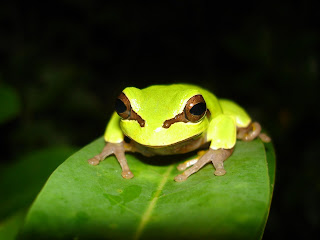



This is what their tadpoles look like. These treefrogs only breed in small, acidic pools (like the one below), with dense cover (second photo down), so they can be pretty difficult to find, or even approach.


Here's a video of one that wasn't too shy to sing in the spotlight:
Though common, I always enjoy finding Green Treefrogs (Hyla cinerea).


These next two species are very similar in appearance, both having mottled, bumpy skin, with light marks below the eyes. In hand, it's pretty easy to tell them apart, and if they vocalize, they sound completely different.

Bird-voiced Treefrog (Hyla avivoca)

Cope's Gray Treefrog (Hyla chrysoscelis)
With their flexible, sticky toepads, treefrogs are adept at grabbing on to and climbing almost anything. They don't, however, have exclusive claims on climbing skills. The Spring Peeper (Pseudacris crucifer), usually seen on the ground, is also quite capable of climbing like a treefrog and could understandably be mistaken for one in the position seen below.

Pine Woods Treefrog (Hyla femoralis)

Spring Peeper (acting like a treefrog)
This first salamander is especially interesting to me, because it is a species that has not yet been described in literature. It will probably be called the Eglin Ravine Dusky Salamander (Desmognathus ?), and is in the process of being worked up by Bruce Means.


Dwarf Salamander (Eurycea quadridigitata)

Three-lined Salamander (Eurycea guttolineata) (I couldn't resist including this video of one walking. I love how they move.

One of my favorites, Marbled Salamander (Ambystoma opacum)

Similar to the amphiuma that I posted recently, and another species as yet undescribed in literature, this is a Siren (Siren cf intermedia).
This first snake was the oddest lifer snake I've ever seen. It's an albino Southeastern Crowned Snake (Tantilla coronata). My friend Norm Friedman spotted it.

In North America, a relatively few snake species have some ability to protect themselves with powerful venom. Interestingly, at least 25-35% of our harmless snake species arguably enjoy some degree of protection by mimicking those venomous snakes (H. Greene, Snakes 1997). The Dusky Pigmy Rattlesnake (Sistrurus miliarius barbouri), a pitviper, is an example of a venomous "model" species on which a few mimic species can piggyback.

Dusky Pigmy Rattlesnake
This young Eastern Hognose (Heterodon platyrhinos) is an example of a pitviper mimic that could be confused for a pigmy rattler. Besides having a similar appearance, hognose snakes will supplement the effect by putting on some pretty threatening displays (see recent post for video of this).


Eastern Hognose

Redbelly Snake (Storeria occipitomaculata)
This was a rare occasion where a Florida Softshell (Apalone ferox) was actually far enough from the water that it couldn't retreat when I approached it.

I found these last two shallowly submerged in backwaters of the Yellow River where they were sleeping at night.

Loggerhead/Stripeneck Musk Turtle intergrade (Sternotherus minor)

young Florida Cooter (Pseudemys floridana)

3 comments:
I love the hognose on your hand! That is one of the best pictures yet. Good videos too. Amazing pictures, thanks for posting.
Thanks Ben! I wish you could've seen that little hog. I'm used to the adults doing the flattening and hissing, but this little guy was doing all kinds of other funny stuff, including lots of gaping and playing dead. Not sure what he was trying to pull off when I took the photo on my hand.
It's fascinating to learn about all these different types of amphibians and reptiles.
Post a Comment